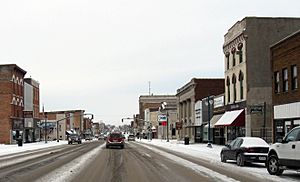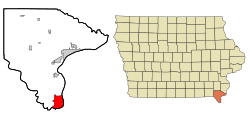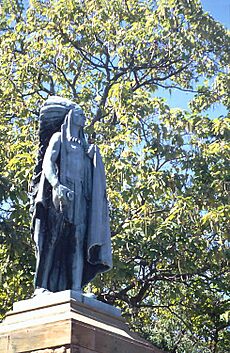Keokuk, Iowa facts for kids
Quick facts for kids
Keokuk, Iowa
|
|
|---|---|

Main Street (January 2009)
|
|
| Nickname(s):
"The Gate City", "Power City", "Geode Capital of The World"
|
|

Location within Lee County and Iowa
|
|
| Country | United States |
| State | Iowa |
| County | Lee |
| Founded | 1832 |
| Incorporated | December 13, 1848 |
| Government | |
| • Type | Mayor–council government |
| Area | |
| • Total | 10.55 sq mi (27.32 km2) |
| • Land | 9.10 sq mi (23.57 km2) |
| • Water | 1.45 sq mi (3.75 km2) |
| Elevation | 568 ft (173 m) |
| Population
(2020)
|
|
| • Total | 9,900 |
| • Estimate
({{{pop_est_as_of}}})
|
9,623 |
| • Density | 1,088/sq mi (420.08/km2) |
| Time zone | UTC−6 (Central (CST)) |
| • Summer (DST) | UTC−5 (CDT) |
| ZIP Code |
52632
|
| Area code | 319 |
| FIPS code | 19-40845 |
Keokuk is a city in Lee County, Iowa, United States. It is one of the county seats. Keokuk is Iowa's southernmost city. In 2020, about 9,900 people lived there.
The city is named after Chief Keokuk of the Sauk people. You can see a statue of him in Rand Park. Keokuk is located where the Des Moines River meets the Mississippi River. It is also where U.S. Routes 61, 136, and 218 meet. Nearby towns across the rivers include Hamilton, Warsaw, Illinois, and Alexandria, Missouri. Keokuk is a main city in the Fort Madison-Keokuk micropolitan area. This area includes all of Lee County, Iowa, Hancock County, Illinois, and Clark County, Missouri.
Contents
History of Keokuk
The area that became Keokuk was a great spot for early settlers. It was between the Des Moines and Mississippi rivers. This gave people access to a large area for trading.
In 1820, a doctor named Samuel C. Muir settled here. He built a log cabin for his family. He was the first white settler in the area.
As more steamboats traveled on the Mississippi River, more European Americans moved to the area. Around 1827, John Jacob Astor opened a trading post. It was part of his American Fur Company. This area became known as "Rat Row."
An early visitor, Caleb Atwater, described Keokuk in 1829. He said it was a small village with about twenty families. There was a store and a tavern. Many Native Americans were fishing. The sound of the river and their fires made the nights interesting.
This settlement was part of a special land area created in 1824. It was called a Half-Breed Tract. This land was for people who had both Native American and European parents. These mixed-race people often did not have land in tribal areas. Native Americans saw this settlement as a neutral place. In 1837, the U.S. Congress changed the rules. This led to a rush for land.
The settlement kept growing because of the riverboat trade. It became known as Keokuk after the Blackhawk War in 1832. The city was officially formed on December 13, 1847. Captain W. Clark became the first mayor. On December 14, 1848, Keokuk became a city.
In 1853, Keokuk was a starting point for Latter-Day Saints pioneers. About 2,000 of them passed through the city. They were heading west on their handcart journey.
Keokuk was home to Orion Clemens. He was the brother of Samuel Clemens, also known as Mark Twain. Mark Twain visited his brother often. He wrote about the beauty of Keokuk in his book, Life on the Mississippi.
Because of its location at the start of the Mississippi River rapids, Keokuk was called the "Gate City." During the American Civil War, Keokuk was a place where Union soldiers started their journeys. Injured soldiers were also brought back to Keokuk for care. Several hospitals were set up. A national cemetery was made for those who died.
After the war, Keokuk continued to grow. A medical college was started. A major-league baseball team, the Keokuk Westerns, began playing in 1875.
In 1913, Lock and Dam No. 19 was finished on the Mississippi River. By 1930, Keokuk's population reached over 15,000 people. In the later 1900s, Keokuk relied less on river trade. More jobs came from local factories.
Geography and Climate
Keokuk is in the very southeast corner of Iowa. It sits along the Mississippi River. The Des Moines River is just to its northeast. Hamilton, Illinois, is across the Mississippi River to the east.
The city covers about 10.58 square miles (27.32 km2). Most of this is land, about 9.13 square miles (23.57 km2). The rest is water. The lowest point in Iowa is near Keokuk. It is where the Des Moines and Mississippi Rivers meet. This spot is where Iowa, Illinois, and Missouri all touch.
Keokuk's Weather
Keokuk has a humid continental climate. This means it has warm summers and cold winters. It holds the record for the highest temperature ever in Iowa. It was 118°F (48°C) on July 20, 1934.
| Climate data for Keokuk, Iowa (1991–2020 normals, extremes 1896–present) | |||||||||||||
|---|---|---|---|---|---|---|---|---|---|---|---|---|---|
| Month | Jan | Feb | Mar | Apr | May | Jun | Jul | Aug | Sep | Oct | Nov | Dec | Year |
| Record high °F (°C) | 72 (22) |
78 (26) |
88 (31) |
92 (33) |
102 (39) |
104 (40) |
118 (48) |
110 (43) |
102 (39) |
94 (34) |
82 (28) |
73 (23) |
118 (48) |
| Mean maximum °F (°C) | 57.4 (14.1) |
62.1 (16.7) |
73.8 (23.2) |
82.7 (28.2) |
88.5 (31.4) |
93.7 (34.3) |
96.5 (35.8) |
96.4 (35.8) |
91.9 (33.3) |
84.9 (29.4) |
71.0 (21.7) |
60.1 (15.6) |
98.5 (36.9) |
| Mean daily maximum °F (°C) | 33.0 (0.6) |
38.0 (3.3) |
49.7 (9.8) |
62.4 (16.9) |
72.8 (22.7) |
82.0 (27.8) |
85.6 (29.8) |
84.0 (28.9) |
77.4 (25.2) |
65.0 (18.3) |
50.5 (10.3) |
38.2 (3.4) |
61.6 (16.4) |
| Daily mean °F (°C) | 24.9 (−3.9) |
29.1 (−1.6) |
40.1 (4.5) |
51.9 (11.1) |
62.7 (17.1) |
72.3 (22.4) |
76.1 (24.5) |
74.4 (23.6) |
66.8 (19.3) |
54.7 (12.6) |
41.6 (5.3) |
30.3 (−0.9) |
52.1 (11.2) |
| Mean daily minimum °F (°C) | 16.7 (−8.5) |
20.3 (−6.5) |
30.6 (−0.8) |
41.4 (5.2) |
52.6 (11.4) |
62.5 (16.9) |
66.6 (19.2) |
64.8 (18.2) |
56.3 (13.5) |
44.4 (6.9) |
32.6 (0.3) |
22.5 (−5.3) |
42.6 (5.9) |
| Mean minimum °F (°C) | −3.2 (−19.6) |
1.6 (−16.9) |
12.7 (−10.7) |
28.6 (−1.9) |
40.2 (4.6) |
52.4 (11.3) |
58.9 (14.9) |
56.5 (13.6) |
43.2 (6.2) |
30.7 (−0.7) |
17.5 (−8.1) |
4.4 (−15.3) |
−7.0 (−21.7) |
| Record low °F (°C) | −22 (−30) |
−27 (−33) |
−11 (−24) |
11 (−12) |
28 (−2) |
40 (4) |
50 (10) |
43 (6) |
30 (−1) |
13 (−11) |
−3 (−19) |
−20 (−29) |
−27 (−33) |
| Average precipitation inches (mm) | 1.61 (41) |
1.82 (46) |
2.54 (65) |
4.21 (107) |
5.26 (134) |
5.21 (132) |
4.08 (104) |
3.77 (96) |
3.42 (87) |
3.32 (84) |
2.56 (65) |
1.95 (50) |
39.75 (1,010) |
| Average precipitation days (≥ 0.01 in) | 8.0 | 7.9 | 9.1 | 11.0 | 12.6 | 10.4 | 9.4 | 7.6 | 7.1 | 8.6 | 7.9 | 7.7 | 107.3 |
| Source: NOAA | |||||||||||||
People of Keokuk: Demographics
| Historical population | |||
|---|---|---|---|
| Census | Pop. | %± | |
| 1850 | 2,478 | — | |
| 1860 | 8,136 | 228.3% | |
| 1870 | 12,766 | 56.9% | |
| 1880 | 12,117 | −5.1% | |
| 1890 | 14,101 | 16.4% | |
| 1900 | 14,641 | 3.8% | |
| 1910 | 14,008 | −4.3% | |
| 1920 | 14,423 | 3.0% | |
| 1930 | 15,106 | 4.7% | |
| 1940 | 15,076 | −0.2% | |
| 1950 | 16,144 | 7.1% | |
| 1960 | 16,316 | 1.1% | |
| 1970 | 14,631 | −10.3% | |
| 1980 | 13,536 | −7.5% | |
| 1990 | 12,451 | −8.0% | |
| 2000 | 11,427 | −8.2% | |
| 2010 | 10,780 | −5.7% | |
| 2020 | 9,900 | −8.2% | |
| U.S. Decennial Census | |||
2020 Census Information
In 2020, Keokuk had 9,900 people living there. There were 4,138 households. About 2,495 of these were families. The city had about 1,088 people per square mile.
Most people in Keokuk were White (88.2%). About 3.7% were Black or African American. About 0.6% were Asian. And 0.2% were Native American. About 6.7% of people were from two or more races. Hispanic or Latino people made up 2.2% of the population.
About 28.2% of households had children under 18. The average age in Keokuk was 41.4 years. About 25.6% of residents were under 20 years old. And 21.7% were 65 years or older. There were slightly more females (51.5%) than males (48.5%).
Arts and Culture in Keokuk

Keokuk has several interesting places to visit:
- Lock and Dam No. 19: This is a huge hydroelectric power plant on the Mississippi River. It was built in 1913. When it was built, it was the largest power plant and longest dam in the world.
- The Grand Theatre: This is a place where you can watch live performances.
- Chief Keokuk Monument: This monument has a marble slab and a bronze statue. It marks the grave of Sauk leader Chief Keokuk. Nellie Walker created it in 1913.
- Keokuk National Cemetery: A special cemetery.
- Keokuk Veteran's Memorial: A memorial honoring veterans.
- Miller House Museum: A museum to learn about local history.
- George M. Verity River Museum: A museum about river history.
Sports in Keokuk
Keokuk has a long history with baseball. In 1875, the Keokuk Westerns played in the first professional baseball game in Iowa. They played against the Chicago White Stockings (now the Chicago Cubs).
Keokuk also had many minor league baseball teams. They were called the Keokuk Indians, Keokuk Pirates, Keokuk Kernels, Keokuk Cardinals, and the Keokuk Dodgers. Famous players like Roger Maris and Tim McCarver played for these teams.
Keokuk is also known as "The Racing Capital of the World." Many racing drivers from Keokuk have won races and championships.
- Don White won national championships in 1954, 1955, and 1958.
- His brother-in-law, Ernie Derr, won 12 national championships.
- Dick Hutcherson won championships before racing in NASCAR.
- Ramo Stott won championships in ARCA and USAC Stock Car racing.
These four drivers were known as "The Keokuk Gang."
People in Keokuk often support sports teams from Saint Louis, Missouri. This is different from other parts of Iowa.
Education in Keokuk
The Keokuk Community School District has several schools.
- George Washington Elementary School
- Hawthorne Elementary School
- Keokuk Middle School
- Keokuk High School
The middle school was damaged by a fire in 2001. A new school was built next to the high school.
There are also private schools in Keokuk:
- Keokuk Catholic Schools (St. Vincent's School)
- Keokuk Christian Academy
Keokuk Catholic used to have a high school called Cardinal Stritch High School. In 2006, it joined with Holy Trinity High School in Fort Madison.
A campus of Southeastern Community College is also in Keokuk.
Notable People from Keokuk
- Edward P. Alexander, author and educator
- Herman C. Baehr, former Mayor of Cleveland, Ohio
- Orion Clemens, brother of Mark Twain
- William Lane Craig, philosopher
- Samuel Curtis, military officer
- Mary Fels, helper of others and supporter of women's right to vote
- Bud Fowler, first professional African American baseball player
- Nathaniel Lyon Gardner, botanist
- James B. Howell, U.S. Senator
- Howard Hughes, famous aviator and film producer
- Howard R. Hughes, Sr., inventor and father of Howard Hughes
- Rupert Hughes, novelist and uncle of Howard Hughes
- Dick Hutcherson, stock car driver
- Ron Hutcherson, stock car driver
- John N. Irwin, former Governor of Idaho and Arizona
- Edward Kimball, actor
- Elsa Maxwell, famous socialite
- Edward Joseph McManus, judge and Lieutenant Governor of Iowa
- Grace Medes, biochemist
- Samuel Freeman Miller, Supreme Court justice
- Conrad Nagel, actor and co-founder of the Academy Awards
- Richard Page, singer for the band Mr. Mister
- George Pomutz, Union Army officer
- Mike Pyle, NFL player
- Palmer Pyle, NFL player
- Hugh T. Reid, Union Army general
- Jack Saltzgaver, Major League Baseball player
- Jeremy Soule, video game music composer
- Frank Steunenberg, former Governor of Idaho
- Ramo Stott, stock car driver
- James Vandenberg, football player
- Don White, stock car driver
- Annie Turner Wittenmyer, social reformer
See also
 In Spanish: Keokuk (Iowa) para niños
In Spanish: Keokuk (Iowa) para niños



